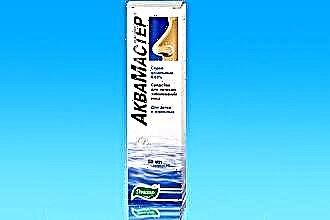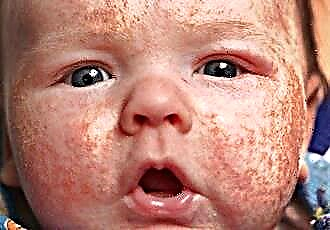Subject to dosages, local preparations do not have a systemic effect on the body. The components of nasal aerosols are practically not absorbed into the bloodstream, therefore they are used to treat rhinorrhea, nasal congestion, sinusitis and rhinopharyngitis in adults and women during pregnancy. The publication discusses the lists of the best sprays, their principle of action and application features.
What it is?
 Spray is a special form of nasal preparation that comes in an aerosol container equipped with a special dispenser. Unlike drops, aerosols cover almost the entire surface of the mucous membrane and are not poured into the laryngopharynx. Particles of a medicinal suspension easily penetrate into the paranasal sinuses, thereby reducing the likelihood of developing sinusitis.
Spray is a special form of nasal preparation that comes in an aerosol container equipped with a special dispenser. Unlike drops, aerosols cover almost the entire surface of the mucous membrane and are not poured into the laryngopharynx. Particles of a medicinal suspension easily penetrate into the paranasal sinuses, thereby reducing the likelihood of developing sinusitis.
Nasal sprays have many advantages over drops. The main ones include:
- no need to take a horizontal position to use a local drug;
- the ability to strictly dose the amount of medicine used;
- achieving the maximum therapeutic effect due to uniform aerosol spraying in the nasal cavity;
- economical consumption of the drug in comparison with nasal drops;
- comfortable injection of the spray into the nose under any conditions - on the street, in transport, in the office, etc.
Injecting an aerosol into the nasal passages not cleared of mucus can cause an infection to enter the paranasal sinuses.
It must be remembered that aerosol preparations are injected into the nose under pressure. In this regard, infected exudate (nasal secretion) can enter the paranasal sinuses. To avoid complications, it is recommended to blow your nose or rinse the nasal cavity with saline before the procedure.
Nasal spray groups
It is rather difficult to understand all the variety of nasal preparations offered by pharmaceutical companies. The pharmacy will offer you a choice of at least 10 types of aerosols, but only some of them will have the necessary therapeutic effect. The choice of topical preparation depends on the etiology, i.e. causes of rhinitis or nasal obstruction (obstruction) of the nasal passages.
Depending on the pharmacological properties of aerosols, the following groups of local preparations can be distinguished:
- antiseptics - disinfect mucous membranes and destroy infections of a microbial, viral and fungal nature;
- corticosteroids - inhibit inflammatory reactions, are used to treat vasomotor and allergic rhinitis;
- antihistamines - relieve swelling and relieve nasal obstruction;
- homeopathic - stimulate local immunity and accelerate cell regeneration in the nasal mucosa;
- moisturizers - prevent dehydration of the mucous membrane and impairment of the secretory function of the glands in the nasopharynx;
- antibiotics - destroy bacteria and prevent the development of purulent processes;
- alpha-adrenergic agonists (anti-congestants) - constrict blood vessels, reduce swelling and the secretion of nasal mucus.
Knowledge of the pharmacological properties of medications allows you to choose the right spray for the common cold of allergic, viral, microbial or fungal etiology. It should be understood that overdose and abuse of aerosols from hotel groups, in particular alpha-adrenergic agonists and glucocorticosteroids, can lead to serious complications.
Review of the best drugs
The main requirement for aerosols is that they not only eliminate the symptoms of nasal obstruction, but also promote recovery. As a rule, nasal sprays are not used as monopreparations for the treatment of acute respiratory viral infections, sinusitis, or nasopharyngitis. A runny nose is only one of the manifestations of the underlying disease, therefore, in order to restore the functions of the respiratory system as soon as possible, it is necessary to take medications of etiotropic action, i.e. systemic antibiotics, antiviral agents, etc.
Rhinitis and nasal congestion are not independent diseases, but symptoms that can be eliminated only if the cause of the disease is eliminated, i.e. infections.
Preparations with sea water
Seawater aerosols are the safest nasal products that can be used without restriction. They contain useful trace elements that have a beneficial effect on the condition of the nasal mucosa. They are indicated for rhinitis and sinusitis of almost any origin.
Depending on the concentration of sodium chloride in the drug, several groups of moisturizing aerosols are distinguished:
- hypotonic ("Aqua Master", "Salin Sense") - the concentration of salts in the preparations is lower than in the blood plasma (no more than 0.65%); easily absorbed into the mucous membrane due to the difference in osmotic pressure of fluids in the mucous membrane and solution;
 hypertensive ("Quicks", "Aqualor Forte") - the content of NaCl is higher than in blood plasma (more than 0.9%); Extracellular fluid is “pulled out” of the mucous membrane, therefore it can be used as decongestants;
hypertensive ("Quicks", "Aqualor Forte") - the content of NaCl is higher than in blood plasma (more than 0.9%); Extracellular fluid is “pulled out” of the mucous membrane, therefore it can be used as decongestants;- isotonic ("Aqua Maris Plus", "Aqualor Soft") - the concentration of sodium chloride corresponds to the content of salts in the blood plasma; they are not absorbed into soft tissues, but they also do not "pull" moisture from them, therefore they are more used to cleanse the nasal cavity from dust, allergens and infectious agents.
Hypotonic solutions are undesirable for nasal obstruction. Their use only increases the swelling in the mucous membrane and therefore aggravates the course of the disease. Such drugs are used in the treatment of atrophic rhinitis and dryness in the nasal mucosa.
Anti-congestants
Sprays containing adrenaline receptor stimulants are symptomatic drugs. They stop the manifestations of nasal obstruction, but do not promote mucosal healing. Such drugs should be used with caution, since their active ingredients affect vascular tone.
When using anti-congestants for more than 7 days, the so-called "rebound" syndrome often develops. When aerosols are rejected, the vessels dilate, which leads to excessive blood filling of the mucous membrane and edema. This forces the person to use drugs constantly with increasing dosage.
Alpha-adrenergic agonists, with frequent use, prevent the secretion of nasal mucus, which leads to tissue dehydration and nosebleeds.
Subject to the recommended dosages, decongestants are not addictive and help to eliminate nasal congestion. The list of the best vasoconstrictor aerosols includes:
- Knoxprey;
- "Nazol";
- "Nesopin";
- Sanorin;
- "Snoop";
- Tizin-Ksilo;
- Lazolvan Reno.
Depending on the composition, some decongestants act for no more than 3 hours, while others are designed for at least 12 hours. With severe rhinitis and before bedtime, it is advisable to use long-acting medications.
Antihistamine sprays
Allergic reactions involving the respiratory tract provoke severe tissue edema, difficulty in nasal breathing, sneezing, lacrimation, itching in the nasal cavity, etc. The progression of the disease can cause obstruction of the Eustachian (auditory) tube and, as a result, impairment of the functions of the auditory analyzer. To reduce the severity of inflammation and symptoms, antihistamine aerosols are used.
Antihistamines are a separate group of drugs that suppress the action of inflammatory mediators, i.e. histamines. Some drugs act directly on mast cells, preventing their destruction and the release of inflammatory mediators, while others reduce the sensitivity of histamine receptors. To cope with the manifestations of hay fever and year-round allergic rhinitis, it is recommended to inject the following drugs into the nose:
- Lekrolin;
- Tizin Allergy;
- "Allergodil spray";
- "Cromohexal".
In severe allergies, antihistamines are used together with topical glucocorticosteroids. Hormonal agents eliminate allergic inflammation and restore the patency of the nasal passages.
Hormonal aerosols
Nasal glucocorticosteroids can be classified as emergency medications. They have pronounced anti-allergic, anti-edematous and antiphlogistic (anti-inflammatory) properties. Sprays with synthetic steroid hormones facilitate nasal breathing, eliminate obstruction and prevent the development of complications - sinusitis, frontal sinusitis, rhinopharyngitis, etc.
An overdose of glucocorticosteroids is fraught with mucosal atrophy, increased intraocular pressure and decreased local immunity.
Hormonal aerosols are more often used in the treatment of allergic rhinitis accompanied by severe rhinorrhea. The best products in this group include:
- "Rinoclenil";
- Beclomethasone spray;
- Tafen Nazal;
- Momat Rino Advance;
- "Dezrinit".
It is undesirable to use topical glucocorticosteroids for the treatment of chronic diseases. With a decrease in immunity, there is a risk of active reproduction in the nasopharynx of opportunistic fungi. They can provoke the development of fungal rhinitis or sinusitis.
Combined aerosols
Combined sprays include drugs that contain several active substances at once, providing them with a wide spectrum of action. In particular, the therapy of allergic rhinitis may include drugs that have both antiallergic and anticongestive action at once. Such aerosols are not recommended to be combined with other nasal agents, since an overabundance of active ingredients can lead to irritation and even greater inflammation of the tissues of the nasopharynx.
 To eliminate several manifestations of rhinitis at once, it is recommended to inject such combined sprays into the nose:
To eliminate several manifestations of rhinitis at once, it is recommended to inject such combined sprays into the nose:
- "Cameton" - softens and disinfects mucous membranes;
- "Pinosol" - accelerates the regression of inflammation and moisturizes the nasal passages;
- "Sanorin-Anallergin" - narrows blood vessels and eliminates allergic inflammation;
- "Vibrocil" - eliminates puffiness and allergies.
"Pinosol" and "Kameton" are herbal medicines. They can be used to treat otitis media and eustachitis, which have arisen as a complication of ARVI.
Antiseptic preparations
Yellow and green nasal discharge is a clear sign of bacterial or fungal inflammation. To eliminate the pathogenic flora in the nasopharynx, sprays with an antiseptic effect are prescribed. They disinfect the mucous membrane and prevent the development of infectious agents, as a result of which the severity of nasal obstruction decreases.
Antiseptics are not antibiotics, so even if treatment is abandoned prematurely, pathogen resistance to drugs does not develop.
To cope with fungal and bacterial rhinitis will help:
- Octenisept;
- Collargol;
- "Dioxidin";
- Okomistin.
An overdose of antiseptics often leads to allergic reactions, as evidenced by itching in the nose, difficulty breathing, watery eyes, etc. Therefore, they need to be used only in those dosages that are indicated in the instructions for the drug.
List of inexpensive sprays
The low price does not always indicate the poor quality of pharmaceutical products. Quite often, the compositions of expensive and cheap nasal agents coincide, which means that the therapeutic effect of their use will be approximately the same. Why are the prices for drugs of the same group so different?
The search for a chemical formula for the production of a new drug and its testing from the manufacturers takes a lot of money. As a rule, it takes at least 10 years from the moment a new drug is tested until it arrives at pharmacies. To recoup the invested finances, the manufacturer is forced to raise the price.
Generics are analogs of original drugs, which contain the same active ingredients. However, for their production and entry into the medical register, the results of clinical trials are not required, and therefore the price for them is much lower than for the original drug. Inexpensive but effective nasal sprays include:
| Drug group | Original | Analogue |
|---|---|---|
| antibacterial | "Isofra" | "Rinofluimucil" "Bioparox" |
| glucocorticosteroids | "Nasonex spray" "Fliksonase" | "Mometasone" "Dexon" |
| immunostimulants | "Grippferon" "IRS-19" | "Ingaron" "Derinat" |
| vasoconstrictor | "For the Nose" "Knoxprey" | "Rinostop" "Rinazolin" |
| antiallergic | "Allergodil" "Cromohexal" | "Rinorus" "Spray nasal" |
It should be noted that the dosage of original drugs and their analogues may differ slightly. This is due to the fact that the concentration of active substances in them is not always the same. Therefore, before using medications, it is recommended that you read the instructions for using the spray.
Conclusion
A nasal spray is a simple and effective way to treat rhinitis and nasal obstruction (nasal congestion). They are equipped with special dispensers that convert liquid into aerosol. During the use of nasal drugs, the drug suspension is injected into the nose under slight pressure, so there is no need to tilt the head back or take a horizontal position.
There are several groups of drugs for intranasal administration, which differ in their pharmacological properties. Depending on the etiology (cause) of rhinitis, antibacterial, antiallergic, antiseptic, vasoconstrictor, immunostimulating, moisturizing and hormonal sprays can be used for its treatment. Combined aerosols belong to a separate group of drugs, since they have a complex effect on the nasopharynx and eliminate several manifestations of rhinorrhea at once.

 hypertensive ("Quicks", "Aqualor Forte") - the content of NaCl is higher than in blood plasma (more than 0.9%); Extracellular fluid is “pulled out” of the mucous membrane, therefore it can be used as decongestants;
hypertensive ("Quicks", "Aqualor Forte") - the content of NaCl is higher than in blood plasma (more than 0.9%); Extracellular fluid is “pulled out” of the mucous membrane, therefore it can be used as decongestants;

